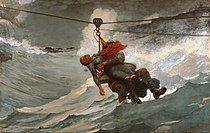Winslow Homer
| Winslow Homer | |
|---|---|

Winslow Homer, 1880,
photo by Napoleon Sarony (1821–1896) |
|
| Born |
Winslow Homer February 24, 1836 Boston, Massachusetts |
| Died | September 29, 1910 (aged 74) Prouts Neck, Maine |
| Nationality | American |
| Education |
Lithography apprenticeship, 1855-56 National Academy of Design (painting), 1863 Paris, France (informal), 1867 |
| Known for |
Drawing Wood engraving Oil painting Watercolor painting |
| Notable work |
Harper's Weekly Magazine Ballou's Pictorial Magazine |
| Movement | Realism |
 |
|
|
|
|
|
|
Winslow Homer (February 24, 1836 – September 29, 1910) was an American landscape painter and printmaker, best known for his marine subjects. He is considered one of the foremost painters in 19th-century America and a preeminent figure in American art.
Largely self-taught, Homer began his career working as a commercial illustrator. He subsequently took up oil painting and produced major studio works characterized by the weight and density he exploited from the medium. He also worked extensively in watercolor, creating a fluid and prolific oeuvre, primarily chronicling his working vacations.
Born in Boston, Massachusetts in 1836, Homer was the second of three sons of Charles Savage Homer and Henrietta Benson Homer, both from long lines of New Englanders. His mother was a gifted amateur watercolorist and Homer's first teacher. She and her son had a close relationship throughout their lives. Homer took on many of her traits, including her quiet, strong-willed, terse, sociable nature; her dry sense of humor; and her artistic talent. Homer had a happy childhood, growing up mostly in then rural Cambridge, Massachusetts. He was an average student, but his art talent was evident in his early years.
Homer's father was a volatile, restless businessman who was always looking to "make a killing". When Homer was thirteen, Charles gave up the hardware store business to seek a fortune in the California gold rush. When that failed, Charles left his family and went to Europe to raise capital for other get-rich-quick schemes that didn't materialize.
After Homer's high school graduation, his father saw a newspaper advertisement and arranged for an apprenticeship. Homer's apprenticeship at the age of 19 to J. H. Bufford, a Boston commercial lithographer, was a formative but "treadmill experience". He worked repetitively on sheet music covers and other commercial work for two years. By 1857, his freelance career was underway after he turned down an offer to join the staff of Harper's Weekly. "From the time I took my nose off that lithographic stone", Homer later stated, "I have had no master, and never shall have any."
...
Wikipedia
